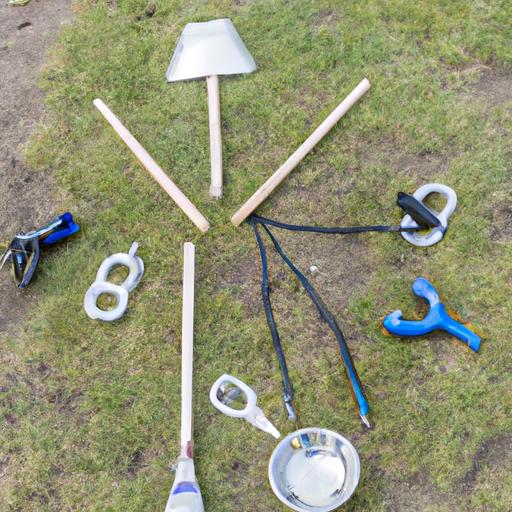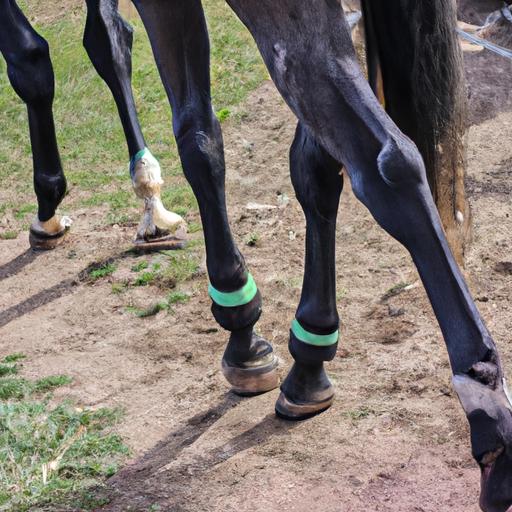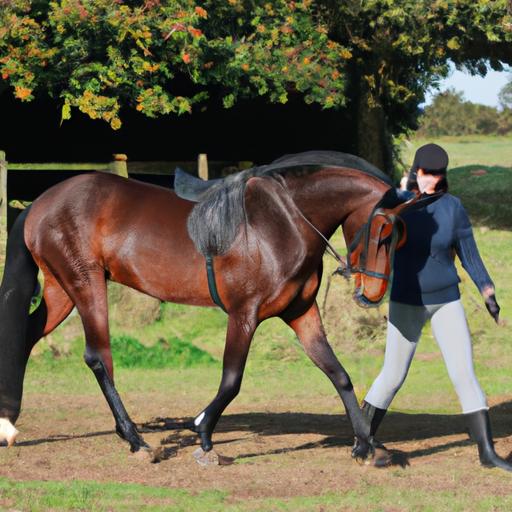Avoid common mistakes in horse training groundwork for better results. Learn tips and techniques to enhance your training journey. Get started now!
Introduction

Are you ready to unlock the true potential of your horse? If you’re seeking a solid foundation for successful horse training, look no further than horse training groundwork. In this article, we’ll delve into the world of groundwork and explore its significance in establishing a strong bond and effective communication with your equine companion.
Horse training groundwork forms the cornerstone of a successful training program. It encompasses a range of exercises and techniques designed to build trust, establish clear communication, and develop essential skills in your horse. By investing time and effort in groundwork, you’ll lay the groundwork for a fulfilling and harmonious partnership with your horse.
Why is Groundwork Essential?

Picture a house without a solid foundation – it may initially stand, but it’s bound to crumble under pressure. The same principle applies to horse training. Groundwork serves as the bedrock of your horse’s education, providing a stable platform upon which to build their training journey. It establishes a strong bond of trust and respect between horse and handler, setting the stage for future endeavors.
Groundwork is not only about teaching commands and cues; it’s about fostering a deep connection with your horse. Through groundwork exercises, you’ll develop a shared language, enabling you to understand and respond to each other’s needs. By investing time in groundwork, you’ll enhance the responsiveness and obedience of your horse, creating a solid foundation for any discipline or activity you choose to pursue together.
So, are you ready to embark on this transformative journey with your equine partner? Join me as we explore the essential tools, step-by-step techniques, and common mistakes to avoid in horse training groundwork. Let’s lay the groundwork for a remarkable partnership that will stand the test of time.
Stay tuned for the next section, where we’ll discuss the essential tools and equipment you’ll need for effective horse training groundwork. Remember, building a strong foundation starts with the right tools in hand.
Understanding Horse Training Groundwork
Definition and Purpose
In the realm of horsemanship, groundwork refers to a series of exercises and activities performed on the ground to establish a solid foundation for horse training. By engaging in groundwork, you lay the groundwork (pun intended) for a successful partnership with your horse. It involves a range of interactions, such as leading, desensitization, and teaching basic commands, all performed without riding.
The purpose of horse training groundwork goes beyond teaching specific skills. It is about building trust, respect, and understanding between you and your horse. Through groundwork, you establish yourself as a reliable leader, gaining your horse’s confidence and cooperation. It is a language of communication that transcends words, allowing you to convey your intentions and expectations effectively.
Benefits of Incorporating Groundwork
-
Establishing Trust: Groundwork serves as a vital trust-building exercise. By working with your horse on the ground, you create a safe environment where they can learn to trust and respect you. This foundation of trust sets the stage for a strong partnership.
-
Enhancing Communication: Groundwork provides an opportunity to develop a clear line of communication with your horse. Through body language, cues, and voice commands, you establish a shared language that allows you to effectively convey your expectations and understand your horse’s responses.
-
Developing Obedience: By practicing groundwork exercises, you instill discipline and obedience in your horse. It teaches them to respond promptly and willingly to your requests, laying the groundwork for a well-behaved and cooperative equine partner.
-
Building Confidence: Groundwork allows your horse to encounter new stimuli and challenges in a controlled environment. By exposing them to various objects, sounds, and obstacles, you help them build confidence and overcome fears, leading to a more reliable and courageous horse.
-
Enhancing Safety: Investing time in groundwork not only improves your horse’s behavior but also enhances safety for both horse and handler. By teaching them to respect your personal space, respond to cues, and remain calm in different situations, you reduce the risk of accidents and mishaps.
As you can see, the benefits of incorporating groundwork into your training program are plentiful. By dedicating time to groundwork, you set the stage for a harmonious and successful partnership with your horse. In the next section, we will explore the essential tools and equipment required for effective horse training groundwork.
Essential Tools and Equipment for Horse Training Groundwork
Tools for Effective Groundwork
When it comes to horse training groundwork, having the right tools at your disposal is crucial for success. Here, we’ll explore some essential equipment that will aid in your training journey:
1. Lead Rope:
A sturdy and well-made lead rope is a fundamental tool for groundwork. It provides a means of communication and control between you and your horse. Look for a lead rope that is of appropriate length and thickness, providing you with a secure grip while allowing ample freedom for your horse’s movement.
2. Training Halter:
A training halter, also known as a rope halter, is designed to distribute pressure evenly across the horse’s head, promoting clearer communication. Unlike traditional halters, a training halter has knots strategically placed to apply gentle pressure on specific points when necessary. This aids in teaching your horse to respond to cues with increased sensitivity.
3. Longe Line:
A longe line is an invaluable tool for groundwork exercises such as lunging. It allows you to guide your horse in a circular pattern while maintaining control and directing their movement. Choose a longe line that is durable, with a comfortable handle and appropriate length for your training needs.
Importance of Tools in Training and Communication
The tools and equipment used in horse training groundwork play a vital role in facilitating effective communication and training. Here’s why they are essential:
-
Safety: Well-designed tools ensure the safety of both you and your horse during training sessions. They provide control and guidance, minimizing the risk of accidents or misunderstandings.
-
Clear Communication: The right tools enable you to convey your cues and commands clearly to your horse. They act as an extension of your body language, enhancing your ability to communicate effectively and precisely.
-
Establishing Boundaries: Tools such as training halters and lead ropes help establish boundaries and reinforce respect between you and your horse. They provide a structured framework within which you can set expectations and guide your horse’s behavior.
Remember, the tools and equipment you choose for horse training groundwork should be of high quality and properly fitted to ensure comfort and safety for both you and your equine partner. In the next section, we’ll delve into the step-by-step guide for effective horse training groundwork. Stay tuned for valuable insights and techniques to enhance your training sessions.
Step-by-Step Guide to Horse Training Groundwork
Are you ready to dive into the nitty-gritty of horse training groundwork? Let’s explore the key steps involved in this transformative process that will bring you and your horse closer than ever before.
1. Building Trust and Establishing a Connection with the Horse
The foundation of any successful partnership lies in trust and connection. Spend quality time with your horse, engaging in grooming sessions, gentle massages, and simply being present. This will help establish a bond built on mutual understanding and respect.
2. Teaching Basic Commands and Cues
Clear communication is crucial when working with horses. Start by teaching your horse basic commands and cues, such as “walk,” “halt,” and “back up.” Use consistent verbal cues and reinforce them with corresponding physical cues to ensure clarity and understanding.
3. Desensitization Exercises for Various Stimuli
Horses can be sensitive to new or unexpected stimulGradually introduce your horse to various sensory experiences, such as waving flags, noise-makers, or plastic bags. Begin with gentle exposure and gradually increase the intensity, rewarding your horse for calm and relaxed behavior.
4. Introduction to Obstacles and Desensitization to Objects
To develop your horse’s confidence and adaptability, introduce them to obstacles such as poles, tarps, and bridges. Encourage your horse to walk over, around, or through these obstacles, rewarding them for their willingness to explore and overcome challenges.
5. Lunging Exercises and Establishing Boundaries
Lunging exercises provide an opportunity to work on your horse’s obedience and responsiveness. Teach your horse to lunge in a controlled manner, responding to verbal and physical cues. This exercise helps establish boundaries and encourages your horse to focus on you as their leader.
6. Leading and Maneuvering the Horse on the Ground
The ability to lead and maneuver your horse confidently on the ground is essential for safety and effective communication. Practice leading your horse in different directions, stopping, backing up, and turning smoothly. This will reinforce your leadership role and ensure your horse respects your guidance.
By following this step-by-step guide, you’ll gradually build a solid foundation of trust, communication, and obedience with your horse. Remember to be patient, consistent, and always reward your horse for their progress. Next, we’ll address some common mistakes to avoid in horse training groundwork. Stay tuned!
Note: In the next section, I will address the common mistakes to avoid in horse training groundwork.
Conclusion
In conclusion, horse training groundwork is the key to unlocking the true potential of your equine companion. By investing time and effort in establishing a strong foundation through groundwork, you’ll build a partnership based on trust, respect, and effective communication.
Throughout this article, we have explored the concept of horse training groundwork and its significance in laying the groundwork for success. We’ve discussed the importance of groundwork in establishing a strong foundation for horse training, as well as the essential tools and step-by-step techniques involved. Additionally, we’ve highlighted common mistakes to avoid in order to achieve better results in your training endeavors.
Now, it’s time to take the reins and apply what you’ve learned. Incorporate horse training groundwork into your training program and witness the transformation in your equine partner. Remember, Rome wasn’t built in a day, and neither is a strong partnership. Consistency, patience, and dedication are key ingredients on this journey.
If you’re looking for further guidance and resources on horse training groundwork, visit our website, Horsemasterypro.com. Our team of experts is passionate about helping you enhance your horsemanship skills and achieve remarkable results with your horse.
So, are you ready to embark on this transformative journey with your equine partner? Embrace the power of horse training groundwork and witness the magic unfold. Your horse is eagerly waiting for you to build that strong foundation. Let’s make it happen together.
Remember, success starts from the ground up. Start your horse training journey with groundwork and watch your partnership soar to new heights. Happy training!


